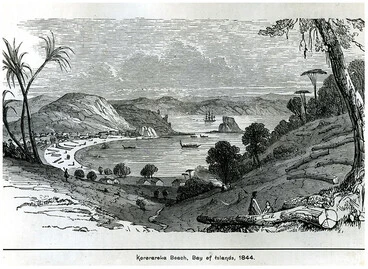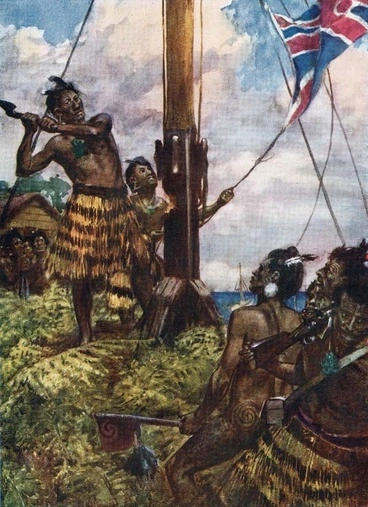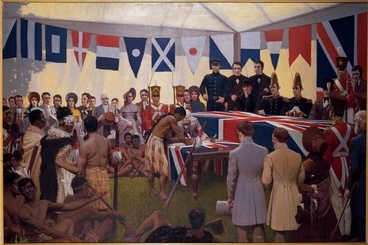Northern Wars
A DigitalNZ Story by jorja packer
By Jorja Packer 10CSH
THE NORTHERN WARS
The Northern Wars had started less than five years after the treaty was signed when a Maori leader challenged British power. Hone Heke was the first to sign the treaty hoping it would benefit his people. However, things took a turn when the capital of New Zealand was moved down to Auckland. Eventually, making Northland poverty- stricken with major loses of business and trade. Hone Heke had protested about the way Maori have been treated after the treaty was signed and the struggle his people had gone through. He cut it down in protest to the hard times they were going through and he was telling them he was no longer in support of the Treaty. When more European settlers had come to New Zealand, they had big losses of land, as they often would confiscate Māori land or buy it of them for low prices. The loss of their land had meant that there would be a decrease in Māori population and culture.
In protest, Hone Heke chopped down the British flagpole in Kororareka, causing the British soldiers to retaliate, which then progressed into the beginning of the Northern War. He had cut down the flagpole three times between July 1844 and January 1845. This then started a retaliation between the Maori and the British on 11 March 1845. He had started an attack on the British soldiers that they had surprisingly won. They had expected the British soldiers to win as they had better weapons in comparison to the Māori's.
During the war, there were some Māori that fought alongside the British and colonial troops. They were known as Kūpapa. They had numerous reasons for fighting against other Māori, some of which were their relatives. They were often traditional enemies of those Māori who were holding out against or resisting the government. Kūpapa had felt the need to have the government on their side to help preserve their own lands and because of the money they would get in the end.The Northern Wars ended up being one of the first, most important challenges towards the Crown in years, after they signed the Treaty of Waitangi. This war was just the beginning of many wars to come.
Hōne Heke fells the flagstaff at Kororāreka
Manatū Taonga, the Ministry for Culture and Heritage
THE AFTERMATH OF THE WAR
These wars affected New Zealanders and their lifestyles because now, they had a decrease of both Maori and British population. The decrease of the Māori population meant that there would be a loss of the Māori culture and its traditions. There were significant losses of land because the Treaty of Waitangi had stated that the Crown had exclusive rights to purchase Māori land. After the New Zealand wars, the Crown had used this to confiscate two thirds of all the land area in New Zealand, taking away most of all the Māori land. They had lost this as a result to fighting against the Crown and the government, ending up causing lots of wars. As the Māori population was on a decline, it gave the British more power as the number of European immigrants was increasing.
Between 1848 and 1864, the Crown had purchased majority of the South Island. The Crown had promised that in return for the land, they would build schools and hospitals and put 10% of the land towards their occupations. The schools and hospitals ended up never getting built and the Māori were left with 37,000 acres of land the Crown purchased. As an outcome, Māori were left in poverty. In the 1860's, throughout New Zealand confiscations took place as the government illegally allowed to take the land of the Māori who had "rebelled" against them during the New Zealand Wars.
Northern war, 1845
Manatū Taonga, the Ministry for Culture and Heritage
IMPACTS ON US
These wars have affected us in the future drastically. It has made problems that resurfaced now including disagreements over land ownership, cultural problems and the loss of Māori population. In the present, many people face problems that have to do with the Māori land wars and the Treaty of Waitangi. A heavy percent of them are to do with land. Many people argue that it was their land in the first place and they should have a right to it, others argue that they brought the land and everything on it and others just want their ancestors land back. People that have problems with land ownership and want to stake a claim to it, have to do it through Waitangi tribunal, where they assess your case and hopefully give the land back to its rightful owner.
It has affected us in many ways to do with the Māori culture too. The language itself is not very well learned to people in New Zealand. Although, schools offer to teach Māori, not all of the schools in New Zealand present Māori as a course language. So, now in the future we have to work harder to preserve our official language, alongside English and sign language, and try to use it in our everyday lives. We now have made the names of places and organisations written both in English and Māori. You can hear Te Reo all around you, including on the television, on radio and in the workplace. People aren't expected to be able to speak Te Reo, but they can be aware of some of the most common phrases and have a basic understanding of Māori culture and customs.
Māori people had a major decrease in population. In 2013, most Māori (86%) lived in the North Island, which is nearly a quarter (23.8%) in the Auckland region. The areas with the highest percentage of Māori after Auckland, were the Waikato region (14%), the Bay of Plenty (11.5%), and the Wellington region (9.7%)
DIFFERENCES IN THE TREATY
The signing of the Treaty of Waitangi was a major turning point for all New Zealand citizens. Two versions of the treaty were made with many differences between the English version of the treaty and the Maori version. The British had a very different understanding of the agreement compared to the Maori. Maori believed that they would still have authority and power over their lands and people. On the other hand, the British intended to have sovereignty over New Zealand and govern Maori people as British subjects.
Major differences in the Treaty included that in the English version, the word sovereignty was used meaning power to make and enforce New Zealand laws. Compared to the Maori version, which used the word governorship which meant that the British would appoint a governor that would have power to control British subjects- meaning the Pakeha, not the Maori. Another difference in the treaty was that the British would protect the Maori when a country came to fight them but that didn't happen. Instead, they would have conflict between the two cultures, which would later lead to war.
Many people argue that the Treaty was made in a rush and by amateurs who didn't know what they were doing when drafting the treaty. Others say the British intentionally used the Maori language to trick the Maori's into thinking they would still have authority over their lands and people. The British had taken advantage that not many Maori people could read. So, Maori had to ask questions and trust the answers.
The treaties and all the agreements in it were not all met. So, to fix the problems in the treaty, now, in the future, we have the Waitangi tribunal. The Waitangi tribunal makes recommendations on cases relating to policies, legislations, actions or omissions of the Crown that are alleged to break the promises that were made in the Treaty of Waitangi. They research and make legal decisions on the claims and cases such as Māori land being taken away illegally or unfairly in the past. Quite often, these would end up finishing with large deals for iwi, including money and land.
Signing of the Treaty of Waitangi
Manatū Taonga, the Ministry for Culture and Heritage
The Treaty of Waitangi
Manatū Taonga, the Ministry for Culture and Heritage
Bibliography
Ruapekapeka, Author Unknown, Date of publication unknown, Accessed on 20 September 2019, https://www.ruapekapeka.co.nz/read/northern-war
NZ History, The Northern War, Updated 18 August 2017, Accessed on 22 September 2019, https://nzhistory.govt.nz/war/northern-war
Calman, R. “ Ngā Pakanga o Aotearoa/ The New Zealand wars”. Ministry of Education school journal. November 2014:10-23
Te Ara - the Encyclopedia of New Zealand, Danny Keenan, 'New Zealand wars - Northern war, 1845–1846', Published 20 Jun 2012, Reviewed & revised 8 Feb 2017, Accessed on 3 October 2019 https://teara.govt.nz/en/new-zealand-wars/page-2
NZ History, Differences between the texts, Updated 20 December 2012, Accessed on 7 October 2019, https://nzhistory.govt.nz/politics/treaty/read-the-Treaty/differences-between-the-texts
NZ History, Origins of the Northern War, Updated 18 August 2017, Accessed on 7 October 2019, https://nzhistory.govt.nz/war/northern-war/origins
Te Ara - the Encyclopedia of New Zealand, Claudia Orange, Published 20 June 2012, Accessed 8 October 2019, https://teara.govt.nz/en/treaty-of-waitangi
Treaty2U, Two parties, two understandings, Author Unknown, Date of publication unknown, Accessed on 10 October 2019, http://www.treaty2u.govt.nz/the-treaty-up-close/two-parties-two-understandings/index.htm




